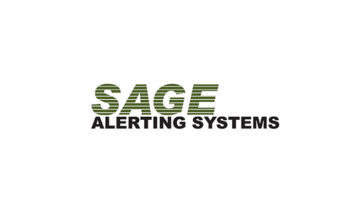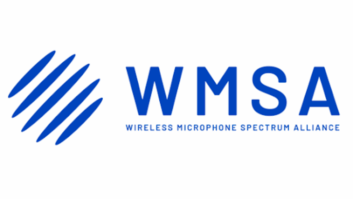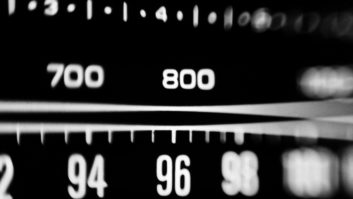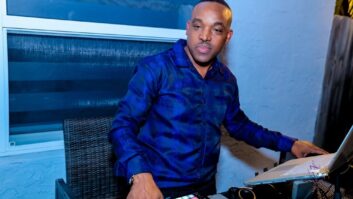WASHINGTON — As NPR’s vice president for distribution, Pete Loewenstein oversees the Public Radio Satellite System, which disseminates content from some 200 program producers to approximately 800 pubcasters.

NPR Vice President for Distribution Pete Loewenstein, right, is congratulated on his 40th year at the network by VP for Technical Operations and Broadcast Engineering Marty Garrison.
The PRSS ContentDepot distribution system streamlines how public radio stations and producers select, send, acquire and automate programming. It uses a combination of Internet and satellite technologies to automate content delivery as well as enable delivery of program-related metadata and emergency communications.
Loewenstein has been in his current position since 1985 but joined NPR as a studio technician in 1971, the network’s first year, and recently passed his 40-year mark there.
He and his team now are involved with “PRSS Forward,” a project to upgrade certain hardware and software components of the system. One aspect involves replacing streaming decoders and storage receivers at some 400 stations. In a phased rollout, International Datacasting Corp. has begun shipping SFX 4104 Pro Audio satellite receivers to PRSS affiliates. Most stations receive two receivers; the units have eight audio outputs, double the capacity as the old receivers. NPR Distribution says the new receivers also provide more audio distribution capability and processing power.
Another part of the distribution project is to build a new National Operations Center for NPR’s future headquarters, with a planned 2013 move-in, while updating the current NOC as well. The operations center runs 24/7 and is responsible for coordinating 1,300 transmissions each week to the channels scheduled by NPR Distribution. The NOC also is the NPR uplink for Washington.
Radio World reported on PRSS Forward in March of 2010. News Editor/Washington Bureau Chief Leslie Stimson spoke with Loewenstein for an update as stations begin to take delivery of new satellite receivers and a thought or two about his career.
RW: NPR is planning to move its headquarters to another location in Washington not far away. Meanwhile, PRSS has a system upgrade project going on at the same time. What is the status of PRSS Forward?
Loewenstein: There are four blocks in the project. We’ve named them Blocks M, O, V and E.
The first one relates to the receivers that we’re deploying to the system, the new technology and the upgrades that go along with that in the NOC here.
The next part would be the buildout, the new NOC. Even though we’re not in the building yet, we’ve started building out the new tech that ultimately we’ll be physically picking up and moving to the new building when we get there. That’s block “O.”
Block “V” is the work we’re already involved in to upgrade local stations’ antenna systems. In some cases it’s replacing the antennas entirely if they’ve become badly damaged or out of compliance. … The final one, Block “E,” is where we physically move ourselves into the new headquarters.
RW: You’re demoing much of the existing space at the new location now. What’s happening in 2012?
Loewenstein: We’ll be starting to build out in the new facility in the fall 2012. We will be packing up and moving out of our current building, as the schedule stands, in the late spring/early summer of 2013. … We’ll be doing a lot of work over there well before that. In fact, we have a satellite antenna that’s transmitting over there already.
The construction work in the building itself is the first step. They’re doing a lot of work now to get the basic building structure completed. That includes a lot of demolition of parts of the old building, then a whole new structure built up around what’s there.
RW: Meanwhile stations have begun to get the new PRSS receivers…
Loewenstein: The receivers that we are deploying with the new technology have been sent to [some] stations and the remaining stations will get theirs … through the fall. So by around Thanksgiving, everybody should have their new receivers delivered to them. Then we’ll begin a period of at least six months or so where we’re running the two systems in parallel. …
This is really meant to be a follow-on to the existing system, but it’s basically adding new technology and new capabilities into what they’ve been used to using. It’s an overlay to what they’re currently using at their station.
The antenna work that I referred to earlier is for those who have very old facilities that need to be upgraded in order for them to be operating properly. Some of them are 20 to 25 years old and weren’t replaced during the last round we went through a number of years ago.
RW: How is the interconnection system upgrade funded?
Loewenstein: All of this work I’ve referred to is funded through a federal appropriation that came in three installments, 2008, 2009 and 2010, as part of the satellite replacement part of the Public Broadcasting Act.
Periodically, roughly every 10 years or so, there has been a special fund created to replace the interconnection system infrastructure at the national and local level. That’s separate from the normal public broadcasting appropriations that happen every year. We in public radio and public television, in the past have had access to these rather major infrastructure upgrades over every 10-year period, including satellite capacity and ground facilities and operating systems.
RW: Any concerns that bubble up from stations as you progress, and is there anything else we should know PRSS Forward?
Loewenstein: From my point of view, we have had probably the least anxious set of station concerns around this “refresh” than any of the ones that we have taken on in the past. But we’re a bit early in it right now, as far as the stations just beginning to get their hands on some of the new things we’re rolling out to them. … We want to hear feedback from stations as this rollout continues as to what concerns or issues they’re turning up.
I guess the fun part — if you can call it that, and I do — is that we’re actually starting to see the physical manifestations of a lot of the thinking, meeting and planning work that’s been going on now for a long time.
The other exciting part is that we’re starting to hear back from the users out in the system for things that we’ve done to make enhancements … that are now causing people to notice improvements that are being made to the overall system performance.
RW: For example?
Loewenstein: There have been some major improvements to the overall interface to the ContentDepot portal, the place where stations and producers spend a lot of their time … I think many would report now that they’re having a much easier time managing how they come in and subscribe to programs.
Even on the input side of the system … [in the past] each little individual segment of a program you had to load as a separate process. You can now go in and load an entire series with one transaction rather than having to do a whole series of them. …
Some of those improvements that we have been making all along are strictly driven by feedback. But others are being baked in as we’re rolling out some of the new software that supports the new systems that are going in. …
RW: Once they get receivers, you’re going to do beta testing and run both systems in parallel for awhile.
Loewenstein: The notion here is, “When you get your stuff, unbox it, put it in service.” Play with it. Get used to it, but still continue to rely on your current system as the main method you use to get your programming.
Then we will find a point, probably around the end of the calendar year, where we declare that all is now ready for people to start using the new stuff as their primary source of getting content in. Then we can start retiring some of the old stuff.

Jane Holmes and Loewenstein, shown in 1973, were part of the original operations staff that managed NPR technical facilities, such as studios, recording center and remote assignments, and scheduled the national interconnection system. The magnetic boards were used to keep track of facility bookings and schedules for the interconnect circuits. Holmes (whose name at the time was Jane Tish) recently retired from NPR.
RW: PRSS is doing Internet distribution as well.
Loewenstein: There’s been a big blending of technologies over the last few years. Satellite is still an extremely important center of our universe, but we also have a very significant investment in using Internet technology, both as a method of bringing content into the satellite system and using the satellite as a delivery vehicle. … It’s one of the subsystems that’s really necessary for the system to operate.
If you are at a local station, for example, and you need to subscribe to a program that we’re going to deliver to you over the satellite, you come in and use an IP connection to a portal that has the way you get in and make your subscription.
If you’re a producer and you’re loading up a file program, you would send your program in to the ContentDepot through an Internet portal connection, and then the satellite takes over and pushes it out to the stations with a lot of enhancements that make it easy for the station to bring it into their local operation.
So it’s really a blend of Internet and satellite technologies that we’re using today. Anytime we find anything we can add into our technology mix that makes things work better, and cheaper and more efficiently — those are things that we’ve been adopting over the years.
RW: NPR Labs is also part of part of NPR Distribution.
Loewenstein: In many ways [NPR Labs is] modeled after the business operation of PRSS, which similarly earns its own revenues and has its own expenses that are separated out from everything else that goes on here. … We have many parts of our two shops that can collaborate with each other because we frequently have common interests or common needs where we can find ways to collaborate and get some efficiencies out of that.
RW: What kind of things are PRSS and NPR Labs working together on?
Loewenstein: Another aspect of the PRSS Forward project … In addition to being able to deliver all the things we ever did in the way of programs to stations through the satellite, the new technologies that we’re rolling out have a rather drastic amount of data delivery capability. A lot of the things that we’re working on now are ways to enhance the connection of the national interconnection system with the local stations to be able to deliver — in addition to their audio content — data services that will be valuable to their local communities. …
Those are just beginning to be possible though the things that we’re in the midst of working on in conjunction with the Labs team.
RW: Where did you grow up?
Loewenstein: I grew up in a little town in Virginia, over in the Shenandoah Valley, not far from here.
RW: How did you get interested in radio?
Loewenstein: I admit to being somebody who’s been entranced by radio from about as early an age as I can remember. Radio is something that to me, still has magic characteristics to it. … The idea that you can have the ability globally to speak to people without a wire being connected to them is kind of an amazing thing to me.
From my earliest times I was fascinated by the fact that I could listen to radio signals from all around the world in my bedroom at night, tucked under the covers with a transistor shortwave radio. Over the years I became a ham radio operator and had the experience of, on a Christmas Eve, having a conversation with people at the South Pole research station, using the power that would light up a light bulb in your home.
RW: You were one of the original NPR employees and you were honored this year on your 40th anniversary.
Loewenstein: May 3 was the 40th anniversary of “All Things Considered.” I was there for the first ATC broadcast 40 years ago, in the studio in the control room as a technician, having first come to work at NPR right before that.
I had the privilege of sitting in the anteroom and watching the show on May 3 this year. If I closed my eyes and listened to what I was hearing, obviously the quality of the content was significantly more mature than it was in those first hours of that first show; but the basic sound I was hearing was very much the same sound I heard 40 years ago. … [But] the production of the content that goes into the show is so drastically different today because of the advent of digital production, digital recordings.
RW: You’re not cutting tape with a razor blade anymore.
Loewenstein: Even the gathering of the audio from the beginning is being done with a different variety of gear; the producing of the segments is different. …
Instead of people running into the room every two seconds with their hair on fire with a 10-inch reel of tape under their arm to be slapped onto the machine two seconds before the intro was done, everything was very calm, collected.
There was probably still somebody with their hair on fire two or three rooms away or maybe a floor away, but none of that was manifested in the studio. It was all being brought in from a digital workstation somewhere else in the building or even from a producer’s desk where they’re working with desktop production materials that didn’t require five people in a studio to get it all produced. …
At some point down the road, radio as we now know it may look very different; but it already looks a lot different than it did 10 years ago and certainly looks a lot different than it did 40 years ago. But it’s going to be around, from my point of view, for a long time.
RW: You’ve been involved in a lot of projects over the years. Which one was the most fun?
Loewenstein: None of us would truthfully say we knew what we were getting into on May 3 of 1971. I think that was fun. It was probably terrorizing to a certain extent because even though we had done a couple of dry runs and drills, we knew we were starting something that had to be right.
That’s a very different experience than dealing with a project that I think a few of us would have liked to have never done, which was having to deal with a failed satellite, Galaxy IV, back in ’98. …
It was a great thing to see the system come together around a major crisis like that. But what it also did, probably in the most dramatic way you could imagine, it was a reminder … of the huge importance of having the interconnection system there and functioning.






